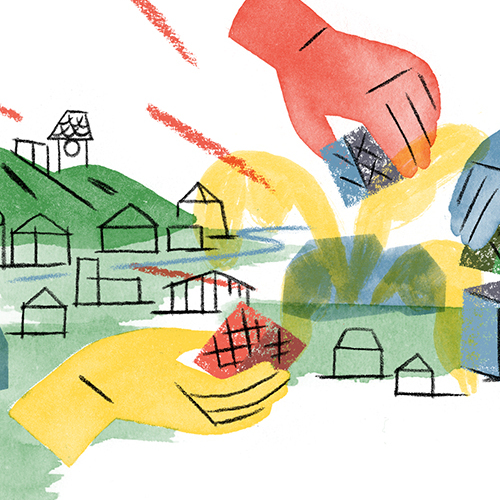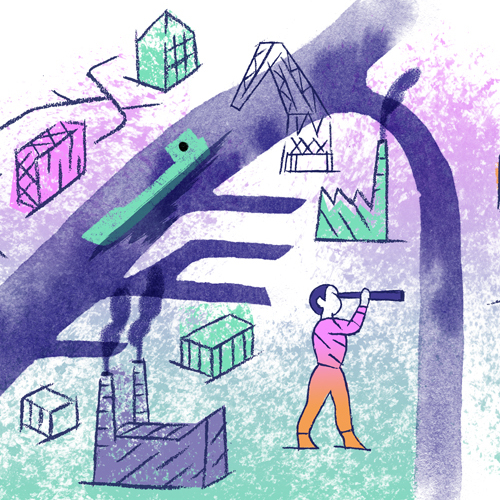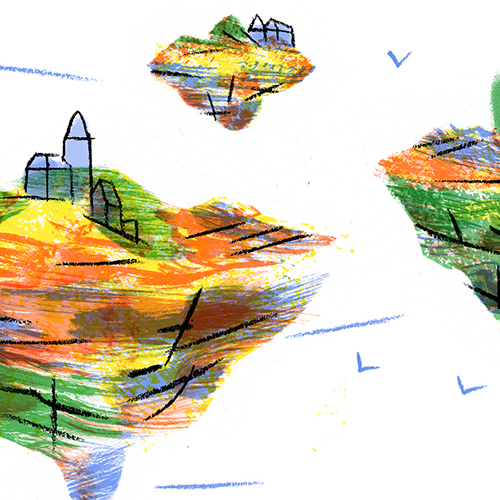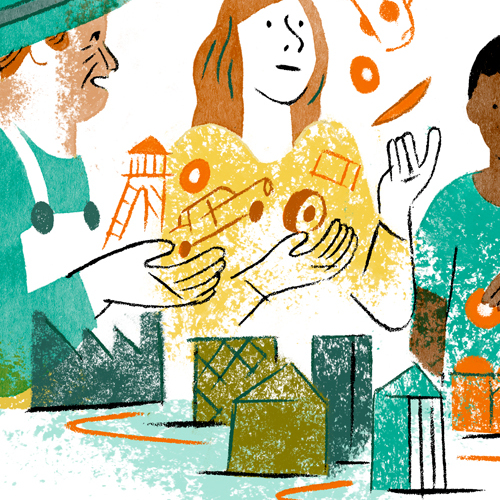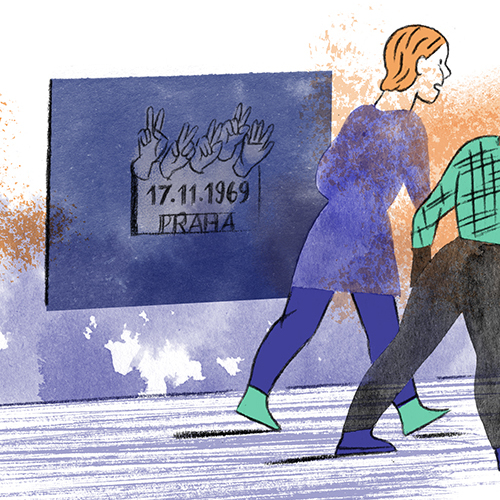 external eye
external eye
Artistic Acupuncture, nine European territories under the artistic microscope
Herman Bashiron Mendolicchio
23/07/2020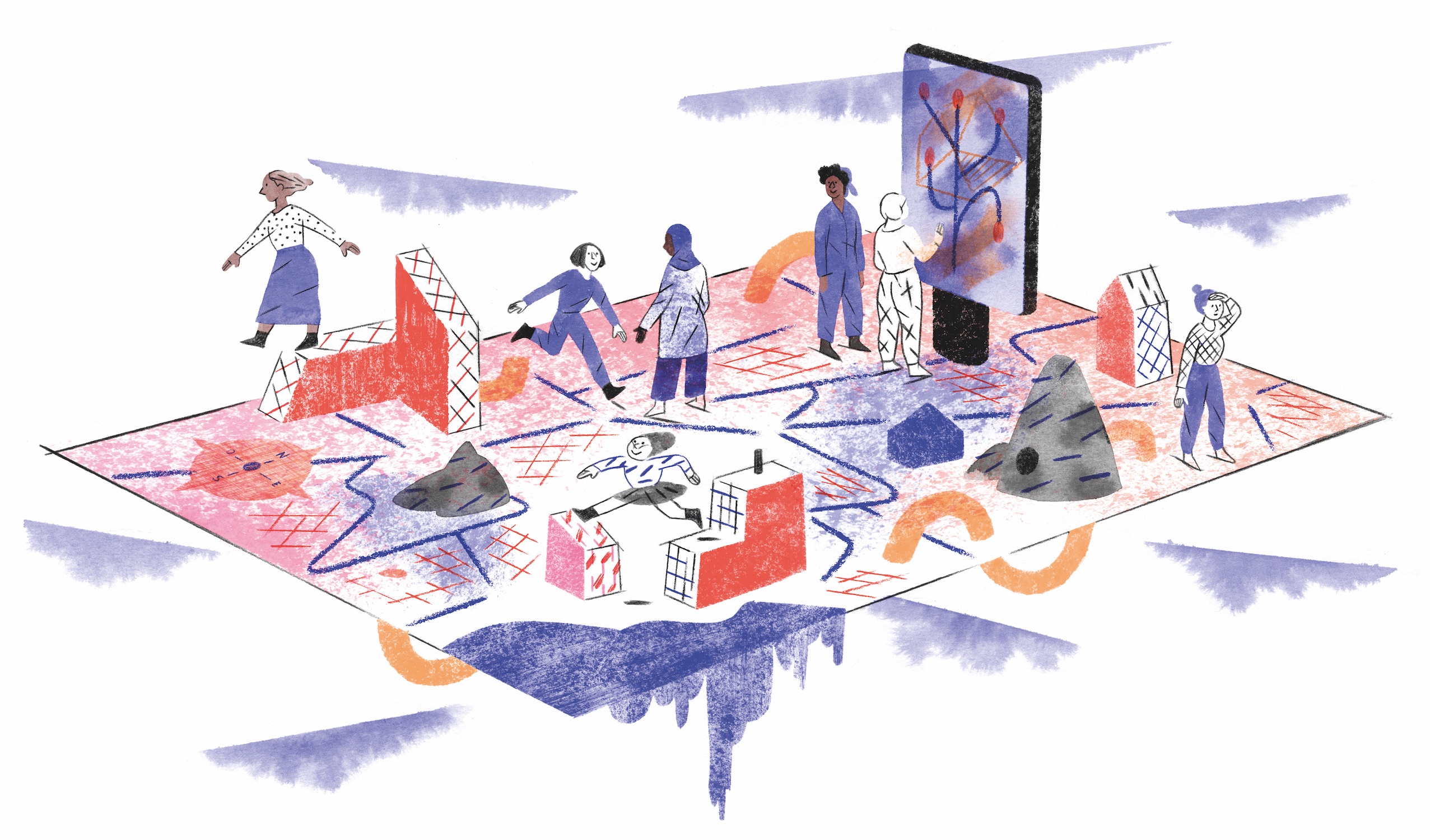
"Let’s now open an imaginary window. What do we see? Is this how we imagine public space?"This final article written by Herman Bashiron Mendolicchio completes the entire series of nine articles about the Artistic Acupuncture missions that took place all over Europe.
Embedded artists for a paradigm shift between public space, arts and civil society |
Let’s start with a simple practical exercise that we can all do by opening any window in our home or workplace. What do we see? A little square with a playground and some kids playing around? A noisy street with cars, huge buildings and packed sidewalks with shops and people walking fast looking busy? A small village suffering the exodus of its inhabitants? A big sign for a real estate company with cranes behind it, ready to disrupt the identity of your neighbourhood? A coastal avenue, empty and silent in wintertime, loud and suffocating in summertime? A public park full of trees? A concrete jungle? A futuristic cityscape? A monument? What are the perceptions and the feelings we have when we look at the space in front of us? And how did it change over the last twenty years? The possible landscapes, stories and scenarios may actually be as many as there are windows in the world, and so also are the peculiarities of public space and the different challenges that revolve around it. The diverse characteristics of public space, for its own mutable essence, are in a constant process of development and change. Public space needs, structures and dynamics vary according to, among others, the geographical, climatic, cultural, technological, political and economic differences that we might find in any place and time. Since the start of the new millennium, and since the widely shared experience of globalization, we could find several definitions that have been applied to public space, with the clear purpose of exploring its traits and highlighting its virtues, features and functions. Participating in another definition exercise is, however, not one of the aims of this article. We would rather engage in a journey through multiple approaches and understandings of public space, conscious that only an on-going process of inquiry and examination might feed the complex and mutable knowledge of what is (related to) public space. Among the most interesting views and reflections that emerge from the sphere of political analysis, we can stress the meaningful link between public space and the development of human rights. In the 2019 report prepared by the UN Special Rapporteur in the field of cultural rights, Karima Bennoune, we find that: “Public spaces are conduits for realizing human rights for all. The human rights framework should be applied to the design, development and maintenance of public spaces in urban, rural, natural and digital spaces. If States, international organizations and the international community do not take the issue of public space seriously and fail to understand it as a basic question of human rights, it will be impossible to fulfil cultural rights, and indeed many other universal human rights”.[1] A public space where human rights can be realized is a space of interdependencies and one where different models of coexistence can be imagined and practised. A recurrent approach asserts that public space should facilitate a dynamic environment for the expression of cultural diversity and cultural values, but, as observed by Jordi Baltà: “Beyond the notion of ‘access to culture’, which may often entail passive reception of cultural works ‘produced’ by artists, the more active notion of ‘participation’ should prevail. (…) In addition to taking part in specific cultural activities such as, for example, the creation of new narratives and works, the right to take part in cultural life requires active involvement in decision-making and in the management of cultural processes and activities”.[2] Participation, collaboration, social and community engagement, enhancing citizens interactions and synergies, recognizing interdependency, developing new models of horizontal design and governance, processes of listening and co-creating, are therefore among the different notions and understandings currently being used to analyse public space and its complex ecosystem. Then, if we move from a theoretical to a more practical approach, what are the methodologies to penetrate into and analyse the challenges of public space and its multidimensional ecosystem? What are the tools to engage with a mutable and evolving context in which a set of very diverse agents and stakeholders operate and interact? From the artistic, architectural and creative field we have an inspiring methodology and practice that opens up other formats to penetrate into the different layers of public space and its multiple challenges: the acupuncture. Drawing on a process which started in the field of urban architecture[3], and conceptually linked to an ancient oriental therapeutic practice originating in China, the acupuncture methodology focuses on locally oriented interventions, with different strategies aiming at involving citizen participation in the on-going inquiry and transformation of public space. By imagining the artist as a needle that can activate and connect multiple points in the body of public space; and by imagining the artistic process as needles that can stimulate and provide a different reaction and understanding about a specific problematic in public space, the IN SITU network has conceived and developed the project Artistic Acupuncture in Europe. Focusing on three main topics – social justice, cultural identity and urban renewal, Artistic acupuncture for places in Europe are an attempt to show how foreign artists can bring a renewed, relevant understanding of societal issues. It is asserted that their observations can create new meaning and shift the perspective on key topics endemic in contemporary societies. |
A European journey through the Acupuncture missionsA group of different artists, between autumn 2018 and the end of 2019, prepared their luggage and began their journeys to their short and intense acupuncture missions. With a traveller’s approach and gaze, they set out to singular and mostly unknown territories, ready to explore and dig into them, and counting on the support of the IN SITU members that were acting as their ‘local guides’. Focusing on a deep research process, developed by connecting with the multiple agents and realities of each local ecosystem, the artists were asked to come up with a creative response, adopting the imagination of an utopian artistic project. Graz, Marseille, Budapest, Pristina, Tàrrega, Genk, Prague, Terschelling and Moss are the 9 cities, the 9 different contexts – with very diverse challenges, landscapes, languages, social dynamics and cultures – in which the Acupuncture missions took place. Equipped with their sensitivity, imagination, vision and creative tools, the artists travelled around the hidden corners of each place, meeting with people, engaging in conversations and trying to enter deeply – and through alternative entry points – into the veins of the specific situation and problematic related to each context. The development and the innovative approaches and strategies of the acupuncture methodology have opened new spheres and layers of practice, research and contemplation, enlarging and deepening the field, the function and the understanding of art in public space. By designing a European journey – reaching and touching multiple and diverse points of the body of the continent – through which the artists and the members of the network have engaged profoundly in an exercise of fruitful encounters, explorations and conversations, the whole Acupuncture project gave way to unexpected processes and discoveries. Focusing on the importance of the artistic process itself – beyond its possible results – the acupuncture missions triggered an inspiring dynamic in which the artists investigated the relational ecosystem of each public space, connecting and discussing with a wide range of citizens and stakeholders, by means of an ethnographic and cartographic methodology. According to James Moore, curator-producer at Østfold Internasjonale Teater, representing the IN SITU member in Norway: “The systematic approach to investigating a particular question/theme/place with a foreign artist enables and obliges encounters and interviews with a broad spectrum of individuals. By interviewing people from both public sector and the civil society, with different professional fields, and with different perspectives and/or positions regarding the topic, we gained a rich and dynamic overview. This relates first and foremost to the mapping character of the Acupuncture exercise”. Throughout this multifaceted as well as tailor-made process of research and creative practice, we can identify a number of specific elements and concepts useful for envisioning the current and future challenges in the field of art in public space. We will try to summarize them in the following points: |
| The future of cities and the cities of future Urban planning and city development should no longer be an issue for only a few stakeholders, but the citizens-residents’ views and perspectives must become essential components that need to be taken into account. As stated in the UN report previously mentioned: “Authorities must establish specialized, cross-disciplinary professional teams responsible for the design, maintenance and conservation of public spaces that are welcoming for all and create mechanisms for citizen participation in the management of such spaces”.[4] In the visionary Artistic Acupuncture developed by Danae Theodoridou in the area of Reininghaus in Graz; in the exploration of the post-industrial district of Csepel, Budapest, realized by Nada Gambier and Mark Etchells; or in the creative analysis of the urban renewal landscape in the city of Moss, carried out by Sjoerd Wagenaar; all the artists have addressed the challenging topic of urban regeneration, stimulating new ideas and perspectives. A shift in public space design requires a creative approach: “Designing public spaces also means taking into account alternative and creative practices based on new techniques of communication and urban usage”,[5] as well as a process of reversing the strategies: “Planning with a focus on public space means reversing this order and starting, rather than from the ‘private city’, from the ‘public city’. It is the concept of public-space led planning”.[6] |
| The right to the village It is time to claim the right to rural public space for a sustainable future, and it is important to consider the emergence of rural space beyond the simplistic discourse of contrast between centres and peripheries. Fostering urban-rural linkages; questioning models of production, distribution and consumption; reclaiming a new space for ecology and for environmental consciousness; and preserving the cultural spaces in rural areas, are some of the urgent matters to take into account related to this field. As demonstrated by the acupuncture mission of Deirdre Griffin in Tàrrega and its surrounding depopulated area, behind a curtain of distance, abandonment and depopulation, the rural areas unfold a deep wealth of knowledge, experience and values that need to be preserved. |
| Refreshing and resignifying the concept of heritage and monument The different components of history and heritage, their representation, meanings and functions, are neither static nor neutral issues, but also depend on shifts in economic and political power. For the acupuncture mission developed in Prague, the artist duo zweintopf addressed the controversial question of political statements in public space and the role of con(temporary) monuments. As highlighted in the analysis of their process, public space has always been identified as the main stage for the performance of political power, and monuments and sculptures are some of its most astonishing instruments. |
| Culturally diverse, plural, inclusive, safe and utopian As previously analysed, public spaces have a fundamental role in the accomplishment of human rights and equality, but unfortunately, beyond the positive will and statements, we also know that many public spaces are the embodiment of the lack of justice, of fear and anxiety. With that in mind, the artist Maria Sideri developed her acupuncture project focusing on the place of women in public space in the city of Marseille. As stressed in the UN report about safe public spaces: “When women and girls are not safe walking on city streets, selling their goods or shopping in marketplaces (…) it has a massive impact on their lives. Both the threat and the experience of violence affect their access to social activities, education, employment and leadership opportunities.”[7] |
| Sharing responsibilities and fostering co-existence Linked to the previous point, we can find different artistic approaches that emphasize how the public environment is a space of rights and duties and a space where different generations and communities co-exist in contemporary intercultural society. Francesca Grilli, through her acupuncture mission in Genk, focused on issues related to the hybridity and the shifting cultural identity of the Belgian city. Morten Traavik explored the challenging frameworks of visa regulations, borders, mobility restrictions, immigration and integration issues in the EU, in the specific context of Kosovo. |
| Public space as the bridge between the local and the global Permanent inhabitants, temporary residents, transient and fleeting passers-by and visitors, often walk through and share the same public space. Who does public space belong to? What are the mechanisms to bridge different needs and uses of the public space? How does the cultural identity of a place change due to the encounter between the global and the local? In her Acupuncture mission in Terschelling, Joanne Leighton interwove stories and experiences, focusing on the particular condition of this tiny Frisian island, which is both home to a small and permanent local community, and host to a huge influx of foreign visitors. The different reflections that emerged from the Artistic Acupuncture missions, the analysis of its importance as a methodological tool, and the different challenges that were pointed out, lead us to make some final observations about this experimental methodology aiming to connect arts and the civil society and to tackle issues that our contemporary society faces. By giving an important weight to the process, carefully avoiding the pressure to achieve rapid, concrete results, the Artistic Acupuncture in public space opens up new fields of practice and research through a rich and multi-layered approach. The main values reside in this constant process of inquiry and exploration; in the development of strategies of involvement and collaboration; in building fruitful interrelations between artists, cultural professionals, local authorities, citizens and communities at large; and in a practice that gives much value to the meaningful and constructive dialogue and exchange between people and places. |
The Acupuncture missions are tools to interrogate an emerging landscape, crossed by diverse and difficult challenges that need to be addressed through different perspectives. The artists act as therapists – connecting again with the curative origin of the term acupuncture – by intervening in situations which are often blocked and need a fresh new gaze on them.
The participatory aspects of art and many other elements discussed are not new in the field of contemporary art, but the focus on public space through the acupuncture methodology does certainly provide alternative visions and strategies to operate from, beyond the more established canons in a highly complex and fast changing ecosystem.
As expressed by Pierre Sauvageot, artist and director of Lieux publics: “It is urgent to invent new modes of exchange”. Art in public space is therefore the field in which we can explore the deeper reality of collaborative, participatory and relational practices. By way of including and relating, this specific art field provides expanded practices that bring together many actors in a process of constant re-contextualization.
The IN SITU network has long been at the forefront of artistic research in public space, identifying the most urgent challenges of the present and anticipating those of the future. Along this experienced journey, the Acupuncture projects have opened the way to a more integrated approach in which artists connect with different layers of civil society. This process will be further developed in the forthcoming project of the network, focusing on a more circular, profound and meaningful exchange between artists and civil society.
Taking care of public space requires a system of new alliances with a plurality of perspectives and, if public space is a space for caring, we should therefore look at the whole world as public space. There is no doubt that this will be better shaped by the visionary contributions of artists.
Let’s now open an imaginary window. What do we see? Is this how we imagine public space?
[1] Report of the Special Rapporteur in the field of cultural rights. Cultural rights and public spaces. 2019. Page 21. Available at: https://undocs.org/en/A/74/255
[2] Jordi Baltà Portolés, “Cultural policies, the right to the city and the right to difference: reflections on the Agenda 21 for culture,” in: Eva Garcia-Chueca and Lorenzo Vidal (Eds.), Advancing urban rights. Equality and diversity in the city, CIDOB, Barcelona, 2019. Page 119. Available at: https://www.cidob.org/en/publications/publication_series/monographs/monographs/advancing_urban_rights_equality_and_diversity_in_the_city
[3] See, among others: Jaime Lerner, Urban Acupuncture, Island Press, 2014; and: Helena Casanova and Jesús Hernández, Public Space Acupuncture. Strategies and Interventions for Activating City Life, Actar, 2015.
[4] Report of the Special Rapporteur in the field of cultural rights. Cultural rights and public spaces. 2019. Page 23. Available at: https://undocs.org/en/A/74/255
[5] Charter of Public Space. Rome, 2013. Page 8. Available at: http://www.biennalespaziopubblico.it/outputs/the-charter-of-public-space/
[6] Pietro Garau, Public Space: a Strategy for Achieving the Equitable City. The UCLG Committee on Urban Strategic Planning. 2014. Page 17-18. Available at: https://www.uclg.org/sites/default/files/uclg-public_space-think_piece.pdf
[7] UN Women, Safe Cities and Safe Public Spaces, 2017. Page 1.
llustrations by Violaine Leroy
Proofreading by Judith Staines
“Artistic Acupuncture Missions” took place in Europe between spring 2018 and late 2019, hosted by 9 IN SITU partners, as part of the ACT project (2016-2020). The concept of this experimental artistic research project is as follows. The partners invite a foreign artist to spend up to six days in their local context to tackle a local issue they have identified beforehand related to one of three themes: social justice, cultural identity and urban renewal. During her/his stay, the artist receives insights from local politicians, activists, social workers, inhabitants… With a traveller’s eye, a fresh and perhaps slightly irreverent way of looking, she/he will come up with a proposal for a future artistic intervention. This proposal may or may not be realised. It will be valued as a unique artistic perspective of a specific European context, illustrative of the artist’s particular way of reading social spaces.
